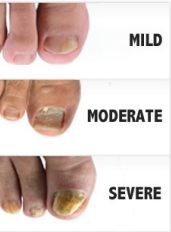Laser for Toenail Fungas
Onychomycosis is a fungal infection of the nail plate. It makes up about half of most nail abnormalities and is common in occurrence. It is estimated to affect 10% of the population and 30% of those over the age of 60.
Signs and Symptoms of Nail Fungas
Crumbling nail plate, distorted shape, yellow to white discoloration or dark streaks, odour, debris beneath, distortion and thickening of plate.
Fungal nails can be difficult to treat as the infection lives in the nail causing destruction to the plate. Products that are painted onto the nail do not always penetrate the plate and are therefore only partially effective at treating the infection.
A sample of the nail can be taken for pathology to test the fungus. If not enough of the active fungus is taken the result may be negative, which is known as a false negative.
At Sports medicine institute our Podiatrist can help diagnose the fungal infection by clinical appearance.
Pathology is only required in rare circumstances where the infection may be a Mould or a Candida type infection, or if considering oral medication. Most infections are due to a dermatophyte organism.

Treatment Options
Antifungal medication prescribed from a doctor may be recommended if you have a severe infection (into the base of the nails). Our Podiatrist will be able to refer you if this is indicated and is often only advised if too extensive.
Oral medications have similar efficacy to the laser, which is approximately 70-80%.
Terbinafine and Itraconazole are the most commonly prescribed medications for nail fungus. One advantage is that it can clear fungal infections of the skin as well.
The disadvantage is that you may need to take these medications for several months and if you stop using it too early, the infection can reoccur.
The medication is absorbed into the bloodstream and processed by the liver, so if you are already taking other medications, it may not be suitable. Side effects can include nausea, diarrhea, headache, and metallic taste.
Laser Treatment at Sports Medicine Institute
The 1064 beam penetrates through the nail to effect fungus without damaging surrounding tissues.
The pathogen that causes fungus is targeted and the new nail can then grow through clear of infection.
Laser is an alternative option for patients who cannot or do not want to take medications. Efficacy rates are 70-80%, other advantages are: –
- there is no anesthesia
- no down time, no pain
- minimal side effects.
How does it work? – light is absorbed by the tissues and the heating of the organism then causes coagulation/vaporization of the fungal cells. The new nail bed can grow through clear.
Method – improvement can usually be seen after 2 treatments. Anywhere from 4-6 treatments are usually recommended, then reviewed after 2 months. The new nail must grow through, so full results may take up to 12 months to be seen.
There is evidence to support combining practices of laser and topical antifungal paints for improved efficacy.
It is recommended to remove nail varnish before the treatment and to try and avoid using it while treating the infection. Varnish can occlude the infection causing it to spread.
Good hygiene practices are also Important for resolution. This may include: –
Drying feet well, treat fungal infections of the skin, wearing socks and hosiery, consider throwing out older footwear, wear thongs in communal change rooms/showers, good hygiene practices.
Possible Side Effects (Rare)
Heating of the tissue can cause warmth of the nail and mild discomfort.
This can last in some cases 24-72 hours.
In rare cases skin reactions or swelling of the surrounding tissues.
Our Podiatrist is trained in the use of the laser, and it is delivered in a pulsed systematic application, so this is unlikely to occur.
It is contraindicated in pregnant woman, anyone undergoing cancer treatment and children under 18 years of age.
*Laser treatment is available for rebate with some health funds.
Reference-





